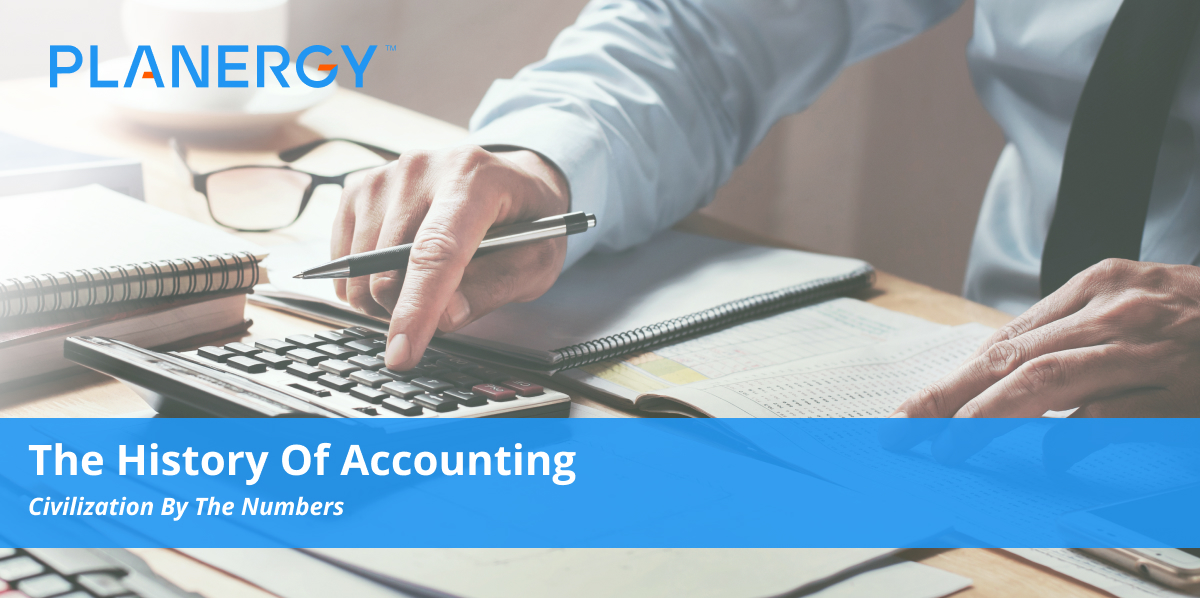In the busy, complex environs of modern business, keeping track of what you owe (and, more importantly, who owes you) can be a daunting job many of us leave to the accounts department with a grateful sigh.
But no matter how advanced, app-driven, and labyrinthine modern accounting gets, it’s still based on double-entry bookkeeping—and hasn’t changed as much over the centuries as you might think.
A (Slightly Abbreviated) History of Accounting
Keeping the books is a practice humans have been refining since before we had actual books.
From the mist-shrouded reaches of prehistory to the computerized accounting methods of the modern age, keeping tabs on the flow of resources is a universal human concern.
The Dawn of Civilization
Ancient Mesopotamia—that storied region that gave birth to human civilization between the ever-flowing Tigris and Euphrates rivers—sparked, and then stoked, the fires of philosophy, medicine, literature, and mathematics 5,000 years before the current era (BCE).
One of the most important gifts carried from the land between the two rivers was basic accounting, first developed in approximately 2,500 BCE.
The rulers of civilizations as varied as Ancient Egypt, Assyria, Sumeria, and Greece all relied on simple accounting to track the gold, food, and other resources trickling into their coffers, as well as resources spent on public works and social programs.
The abacus, made from wire and drilled beads, was used by ancient Egyptians (although they weren’t the only ones) as the world’s first shortage/surplus calculator in 500 BCE.
Around 1,000 B.C., in the seafaring nation of Phoenicia, linguistics blended with commerce to create an alphabet and language centered firmly around commerce and trade and designed for negotiations with Phoenicia’s trade partners.
With everyone literally speaking the same language, it was much easier to avoid being cheated by opportunistic or unscrupulous foreign traders.
The Phoenician alphabet and language was so successful, in fact, that it became the foundation of many alphabets throughout the ancient Mediterranean, including the Roman alphabet that, in turn, gave rise to both Romance alphabets and the modern English alphabet.
Accounting in the Roman Empire
When they weren’t busy picking fights with Carthage, the Romans took time to invest their plunder and profits into public works, social programs, and ornate palaces.
By the 4th century BCE, it was common knowledge that somebody had to keep track of all the goods, gold, and other resources moving in and out of the storehouses.
Since all the reports were spoken aloud, the proto-accountants keeping tabs on the Empire’s bounty did a lot of listening, which is why they were called auditors.
A quick peek at a funerary inscription for Emperor Augustus called Res Gestae Divi Augusti (“The Deeds of the Divine Augustus”) from the turn of the era (14 AD) shows the ruler of mighty Rome had a wealth of accounting information at his fingertips, including exact figures for land grants, public charities, gladiatorial combat expenses, and temple upkeep, as well as the 600,000 silver denarii he spent on public works from his own royal pockets.
During his long life, Augustus likely used the accounting records kept by imperial accountants to make informed decisions about everything from which wars to wage to tax reform.
In time, as machines take much of the drudgery out of accounting and accountants become more concerned with verifying transactions and accounting records than posting them, we may see the role of the accountant shift once again to something resembling Roman auditors.
The Middle Ages: Rise of Double Entry Accounting
Bartering was the name of the exchange game for the common folk during the long centuries after the fall of the Roman Empire in the West and the rise of the merchant class. But in the 13th century AD, Europe began its revolutionary shift to a coin-heavy, currency-driven economic paradigm.
As a result, merchants started tracking both debits (from the Latin debitum, “something owed”) and credits (from the Latin creditum, a loan or thing entrusted to another) in order to have a real-time view of their businesses and plan for expansion and investment.
Creating two entries for each transaction laid the framework for double-entry bookkeeping, and the foundation for our modern accounting systems.
Luca Pacioli: Father of Modern Accounting
In 1494, having spent years observing the business and accounting practices of merchants throughout Italy, an Italian mathematician and Franciscan friar named Fra Luca Pacioli wrote a landmark treatise on the double-entry accounting system.
His Summa de arithmetica, geometria, proportioni et proportionalita (“Summary of arithmetic, geometry, proportions and proportionality”) cemented his legacy as the Father of Accounting and Bookkeeping, and included:
- The first instances of the plus (+) and minus (-) signs in a published work
- The first appearance of algebra in an Italian book
- Integration of classical Greek philosophical concepts based in Geometry with Algebraic computation (effectively shifting the emphasis in contemporary mathematics to execution informed by logic and theory)
- Double-entry bookkeeping, balance sheets, financial statements, trial balances, and even an early forerunner of logarithms used to calculate the likelihood of an investment growing or shrinking
Pacioli, a friend of and collaborator with Leonardo da Vinci, worked as a maths professor and wrote Summa over the course of many years.
He was also responsible for Divina proportione (“Divine proportions”), a work on geometric concepts (illustrated by his friend da Vinci) that helped revolutionize art and design as much as Summa had accounting.
Accounting During the Industrial Revolution
Pacioli’s work was the guiding light for accounting principles well into the 1700s. But when the Industrial Revolution began, and business became a focus of not just commercial but social enterprise, accounting principles and practices expanded.
Double entry accounting was refined with a focus on maximizing efficiency and accountability while minimizing expense in support of newly-minted corporate bodies.
Accountants, rising in importance as more and more businesses sought both market and global domination, banded together to form the first professional accounting organization in the United Kingdom: the Institute of Chartered Accountants in England and Wales.
Not to be outdone in the burgeoning era of corporate expansion, New York accountants in the United States founded the American Association of Public Accountants (AAPA)—in 1887. By 1896, New York state was issuing professional titles and licenses for newly-minted Certified Public Accountants (CPAs).
(Note: By 1957, the association had grown much larger, taken in its smaller brethren, and evolved into the American Institute of Certified Public Accountants (AICPA) we know today.)
Modern Accounting
Despite the relatively short distance from 1900 to our own time, accounting history records a number of significant changes in the century or so that’s elapsed since the turn of the 20th century.
The Wall Street Crash of 1929 made all too clear the need for real and practical accounting reform to reign in fraud, theft, and other criminal embarrassments.
Both the United States Generally Accepted Accounting Principles (GAAP) and the Financial Accounting Standards Board (FASB) were created in the 30s to bring corruption under control and create effective, efficient, and reliable accounting standards and best practices.
Today, FASB and the AICPA continue to expand, enhance, and refine accounting, guided by GAAP. At a more granular level, companies of all sizes are increasingly implementing artificial intelligence and automation via ERP and purchasing software packages to ensure their own practices and policies are both fully compliant with the law and optimized for performance and profitability.
In time, as machines take much of the drudgery out of accounting and accountants become more concerned with verifying transactions and accounting records than posting them, we may see the role of the accountant shift once again to something resembling Roman auditors.
Building a Bright Future on a Storied Past
The history of accounting is, at its heart, a story about organization, economy, and optimization.
And no matter what challenges, opportunities, and technological advances greet the accountants of tomorrow, we can be sure that at the core of both practice and policy will be a version of the same basic double-entry accounting that inspired Pacioli to craft a masterpiece all those centuries ago.
Omnia mutantur, nihil interit, as the Imperial auditors of old might say.




